Mike Saulters's blog
Review: Puss in Boots
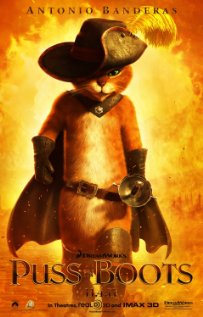
Puss in Boots comes to us during a fall film season with a paucity of releases for children. It's a clever if not brilliant work from Dreamworks Animation and a spinoff/prequel to the title character's entry in the Shrek series. Fortunately, there is no mention of Shrek, and the movie works very well alone without the need for prior knowledge of that world.
Antonio Banderas and Salma Hayek frequently work together, and this is their fifth collaboration (after Desperado, Frida, Spy Kids 3-D and Once Upon a Time in Mexico). They are joined by Billy Bob Thornton (Jack), Amy Sedaris (Jill), and Zach Galifianakis (Humpty Dumpty). Galifianakis is either brilliantly cast or terribly wasted. Personally, his characters always seem to grate on my nerves, but he delivers some of the best one-liners in Puss in Boots. As a family film, though, it's a very light, vanilla creme flavor of humor compared to The Hangover series.
Part origin story, part adventure-heist, Puss in Boots earns points for encompassing an actual story rather than simply throwing pop culture references at the audience, the modus operandus of Shrek. Sadly, a predictable plot is so transparent it doesn't need the incessant telegraphing of every potential surprise move. This is likely more a problem for those who have already seen Puss in the Shrek films. His aresenal is exhausted, and he has no new tricks. You know at some point he'll pull out the big kitty sad eyes, but it's been done before.
As with Shrek, Puss's best moments are when he has a strong character to play against, and those moments here are with Hayek's Kitty Softpaws. Had Puss in Boots been more about a cat-and-mouse game between them and less about Humpty Dumpty, it would have been more interesting.
Besides the Banderas-Hayek chemistry, the brightest spot in the movie was an engaging soundtrack performed by Mexican/gypsy/folk duo Rodrigo y Gabriela. Unfortunately, the soundtrack does not yet appear to be available on iTunes or Amazon.
Photo Essay: 'Young Adult' Surprises Alamo Audiences
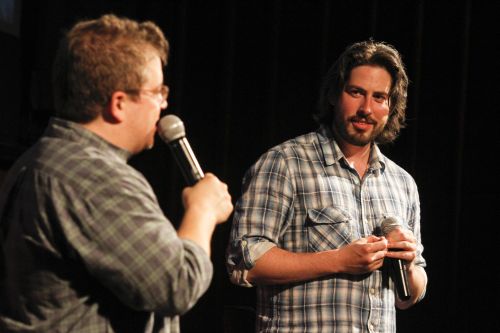
The Alamo Drafthouse on South Lamar played host this week to a "secret screening with special guests." The guests turned out to be filmmaker Jason Reitman (Juno, Up in the Air) and actor/comedian Patton Oswalt.
AFF Review: An Ordinary Family
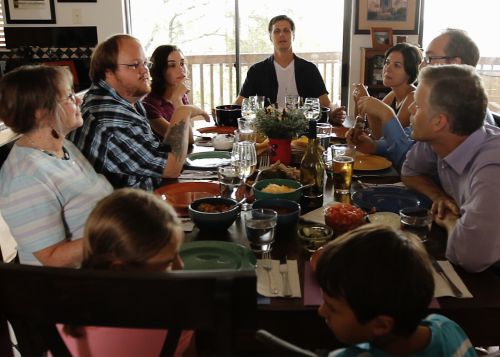
Filmed in Austin, An Ordinary Family highlights the difficulties for a family with a religious background when a member comes out of the closet. After years away from home Seth (Greg Wise) returns for a week with his partner William (Chad Anthony Miller) to meet the family. Each member of the family has a different reaction. For example, brother-in-law Chris (Steven Schaefer) at first finds the situation comical and slightly uncomfortable, but develops a strong bond with William.
The center of the story, however, is Seth's brother Thomas (Troy Schremmer), a Presbyterian minister. Thomas struggles to find peace in order to reconcile acceptance of Seth and William with his faith. It was his intolerance that drove Seth away, and they must come to terms with each other for Seth to consider returning home to rejoin the family permanently.
Review: Paranormal Activity 3
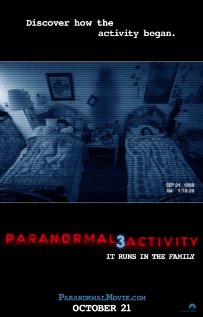
[Note: This review is based on the cut screened during Fantastic Fest, which we were told was not final, and which might feature differences from the theatrical release.]
Just two years ago, on an impossibly small budget, Oren Peli started the biggest new horror franchise of the decade. The writing of this marks the first year of my contributing to Slackerwood which began with a review of Paranormal Activity 2, a clever prequel penned by Christopher Landon. Now Landon continues to extend the franchise and expand on the mythos of Katie and Kristi with another prequel set this time in the 1980s: Paranormal Activity 3. This time, his script is directed by Catfish filmmakers Henry Joost and Ariel Schulman.
This setting provides a challenge for a series of found-footage films, as the home security camera technology featured in the first two movies was not yet available back in the Eighties. (However, large, clunky B/W cctv options were available and could have been used.) To work around this, the girls' father is written as a professional videographer who just happens to have a studio full of the newest VHS camcorders he can bring home to record the strange events that have been occuring around the house. In a very clever feat of duct-tape engineering, he even fixes up one camera on top of an oscillating fan so it can cover both the living room and the kitchen. (Through a feat of magical engineering, these VHS cameras are also able to capture widescreen high-def images.)
The strength of Paranormal Activity 3 is the weakness of the series. The "events" are more aggressive, more powerful and scarier than ever, but with each movie we're moving more into the past. Thus, looking at the events in chronological order, the demon that's tormenting Katie and Kristi is apparently growing steadily weaker even as it appears to grow angrier until at the end someone has to die. While we learn a little more about the sisters and their family with each film, Landon is painting himself into a corner. If there is ever to be a Paranormal Activity 4, it can't stick to the same formula and try to extend even deeper into the past. Yet an attempt to jump the story forward in time could present some difficulty in reconciling with the events seen in previous films.
Review: Footloose
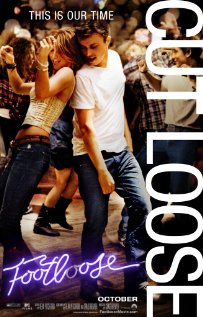
Director Craig Brewer has two critical hits to his name. Both Hustle & Flow and Black Snake Moan were exceptional works from a natural talent. Now, Brewer has taken on the challenge of remaking an 80s classic with Footloose, but the real challenge for him has been one of marketing a fantastic work that people are too ready to dismiss as a blasphemy without having even seen it. In fact, Brewer is perhaps the world's biggest fan of the 1984 movie that made Kevin Bacon a star. He has taken the film on the road, touring cities around the US and stopped in Austin a couple of weeks before Fantastic Fest to present the movie along with star Kenny Wormald. (see photos here)
Brewer has realized an updated yet timeless version of the story about a city boy who brings dance back to a small town paralyzed with grief. Fans of the original will find it hard to dislike this one. Footloose is the same movie in almost every way, but with a couple of background adjustments that result in a better presentation. Nothing revolutionary, but I won't spoil them. You may not even notice consciously, but the result is stronger character motivation and a better film.
Dennis Quaid is much more relatable as a grieving father than the unflinching fire-and-brimstone preacher portrayed by John Lithgow in 1984. This is where Brewer's vision departs from the original. This isn't a story about religious intolerance, and the script makes a pointed remark on that if it wasn't already clear. Kenny Wormald's Ren is a richer, more complex portrayal, still headstrong but more of a golden boy than Bacon's take on the role, and he has a strong relationship with his uncle Wes Warnicker (Ray McKinnon)
Footloose is a movie about dancing, of course, and the cast reflects that. Wormald has been dancing since the age of 6, is an instructor, and was previously seen in You Got Served. Costar Julianne Hough, who plays preacher's daughter Ariel Moore, is best known from Dancing With the Stars. It is Miles Teller's performance as Willard, however, that makes the biggest impression. Following up a strong dramatic performance in last year's Rabbit Hole, he shows breadth as the comic relief here in a very demanding physical role. In fact, the only weak character was Andie MacDowell's Vivien Moore, a part written with the belief in mind that a reverend's wife should be seen and not heard. In most scenes, she smiles and is silent.
Review: The Way
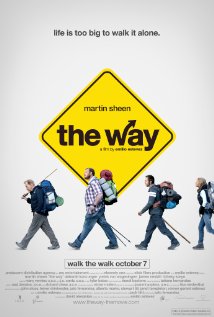
Separation and loss of a loved one, particularly that of a child, is the greatest cause for grief. Until we can learn to accept and deal with that grief, it can be crippling. In Emilio Estevez's latest film, The Way, his father Martin Sheen's character undertakes a task of enormous difficulty to pay homage to the memory of his son and come to grips with his loss.
Tom Avery (Sheen) is a widower, an opthalmologist who spends his free time on the golf course. His relationship with son Daniel (Estevez) is strained as Daniel is having something of a mid-life crisis and drops his graduate studies to travel and see the world. In France, he undertakes a pilgrimage along El Camino d Santiago, a walk of over 800 kilometers to Santiago de Compostela in Spain. But he is killed on the very first night of his journey when a freak storm arises in the Pyrenees.
Summoned to France by the authorities, Tom recalls their last conversation and decides to pick up Daniel's backpack and complete the pilgrimage in his son's place. Along the way, he encounters several people who are themselves coming to grips with personal demons, and they form an unlikely support group.
The Way is a poignant movie, shot along the length of the Camino de Santiago and full of breathtaking views of remote mountain villages, farmlands and cathedrals. The scenery alone is enough to elicit tears, without the grave import of Tom's journey. At key places along the route he stops to spread his son's ashes.
As if planting the seeds of his own redemption, Tom's personality begins to bloom with the help of his companions. The first, Joost (Yorick van Wageningen) is a Dutch bon vivant who hopes the walk will help him lose weight, though he can't help sampling heavily of the local cuisine at each stop. The second, Sarah (Deborah Kara Unger), intends to quit smoking at the end of the journey. The last, Jack (James Nesbitt) is an Irish travel writer stuck in a career rut.
Fantastic Fest Interview: Harry Knowles, 'Comic-Con Episode Four'
Austin's Harry Knowles is the creator and editor of the website Ain't It Cool News and a co-founder of Fantastic Fest. In addition, he's produced a documentary, Comic-Con Episode Four: A Fan's Hope, which was this year's Fantastic Fest closing-night selection. The movie is a look inside San Diego Comic-Con and is directed by Morgan Spurlock; the film's other producers include Joss Whedon and Stan Lee. You can read Jette's review for details.
I sat down with Knowles before the fest began to ask him a few questions about Comic-Con Episode Four.
Slackerwood: You've worked at producing other films, such as John Carter of Mars and Ghost Town. How did you get involved in this one, and why do you think this is the first one to be made after others fell through?
Harry Knowles: With John Carter, it was a situation where the studio kept changing hands. Every single time we had a new studio head we had to get a new director, which was counter-productive. Every time we had a script that we all agreed we were going on, suddenly the head of the studio would change and we'd have to basically start from scratch again, which was a demoralizing sort of thing. And with Ghost Town, Revolution Studios went under before we were able to make the film. Since then I've been pretty quiet about everything I've been producing, because the thing you learn when you're working in the film business is, it's not real until it is in the can and on Blu-ray.
Review: Real Steel
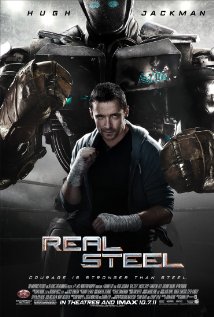
In jest, I'm calling it "Robot Rocky" to my friends, but Real Steel is the most fun I've had in a theater all year. Call it a movie for 11-year-old boys if you like. It certainly has enough action, but it's a great family film with solid appeal for all ages.
Hugh Jackman is admittedly not at his best here; Charlie Kenton is not Jackman's usual heroic role. However, newcomer Dakota Goyo (who made a brief appearance earlier this summer as a young Thor) will be making a name for himself with Real Steel. The movie is almost entirely one-on-one between the two, and Goyo holds his own against a much older and more seasoned actor.
Evangeline Lilly's Bailey is charming but little more othan an afterthought in this script, present only to provide a little exposition on Charlie's backstory. Kevin Durand rounds out the main cast with an unsurprisingly bad guy named Ricky. It would be refreshing just once to see him play a sympathetic character, but now when he shows up in the credits, I automatically know he'll be showing up as a villain.
I was surprised to see Danny Elfman credited with the score. His muted guitar work was a mighty leap from the direction of familiar (and beloved) pieces like Beetlejuice and Batman. Instead of a circus musicbox chorus, Elfman scored Real Steel with a country sound reminiscent of Gustavo Santaolalla's in Brokeback Mountain. Much of the film is set in Texas (although shot in Michigan), so the feel is appropriate.
Fantastic Fest 2011, Day Eight: Not With a Bang But a Blowout
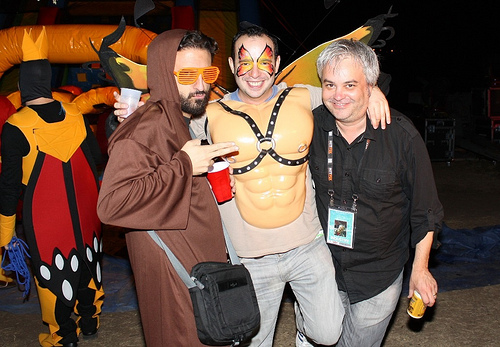
The last day of Fantastic Fest is often the most relaxed. Many have left to return home, and the Alamo patio feels like a ghost town compared to the first few days. Instead of five screens, films were playing on only three. Still, many of the best shows remained to be seen, including several fan-favorites with added screening times such as A Boy and His Samurai.
The day began with a South Korean thriller reminiscent of Audrey Hepburn's Wait Until Dark. Blind is the story of Min Soo-Ah, a no-nonsense police academy trainee. Min's brother has a habit of getting into trouble of a criminal nature, and fed up with his latest exploit, she arrests him and handcuffs him to the car. The ensuing sibling catfight ends in a disastrous wreck, leaving Min blind and her brother dead. Min is expelled from the academy, not for her handicap, but for her irresponsible actions. Three years pass, and after Min is nearly abducted by a serial killer, she is the only witness who can help track him down. Unfortunately, nobody considers her a credible witness, not even the detective working her case. This was an exciting movie which, unfortunately, too many people compared to Daredevil. It works best in scenes where the emotional impact is high such as the wreck that blinds her, and the ongoing process of working through her guilt over that.
Two-time Fantastic Fest director Aleksey Balabanov (Cargo 200, Morphia) returned with another glimpse into an obscure corner of Russian history, Kochegar (The Stoker). This film tells a simple story about a broken war hero who lives only to support his daughter, shoveling coal into an industrial boiler day and night. The very simple story is stretched to 87 minutes, and we are introduced to the topic of racism in Soviet Russia by tales he tells of his native Yakut people as he entertains two local girls who visit him. Ultimately a tragic story, but a fascinating picture of life, death and revenge served cold.
Fantastic Fest 2011, Day Five: The Second Half Begins
Day Five marks the beginning of the second half of the fest. Many of the filmmakers and industry people have left, and new fans arrive attending with second-half badges. The tone of the festival becomes more relaxed, but unfortunately, the FEARnet-sponsored free ice-cream truck has departed. Some of the better parts of the fest are still yet to come. As I'm writing this, the awards are about to begin, hosted by Devin Steuerwald. Jette will be covering the results separately. I'll end the day with the signature party, Fantastic Feud.
I began the day with movie film that has made waves at the fest this year, earning a runner-up in the Fantastic Fest Audience Award category. Juan of the Dead (Juan de los Muertos) is a unique interpretation of the zombie apocalypse. Set and shot in Cuba, Juan pokes fun at the same films that serve as its inspiration and includes several jabs at the political situation. Juan, the titular character, is an affable screw-up who spends his days fishing from a raft and sneaking into his lover's boudoir while her husband is away. When zombies start to appear (the state media reports the phenomenon as political dissident attacks sponsored by the U.S. government), Juan and his friends decide they're better at zombie killing than the government and attempt to turn a profit by starting a business exterminating for their neighbors. As the zombie plague grows out of control, their plans must evolve from control to escape. This was a lot of fun, full of surprises and interesting kills.
The next part of the day was the Short Fuse: Horror Shorts program, which included nine short films from around the world. One of the highlights of this program was Austin-produced No Way Out (read Rod's interview with writer Eric Vespe and director Aaron Morgan). Fest regulars Dennis Widmyer and Justin Duprie, who hails from Corpus, wrote and produced the exceptional horror-comedy short Curtain, which makes The Exorcist look tame by comparison. Other great shorts included The Unliving and How to Rid Your Lover of a Negative Emotion Caused by You!, the runner up and winner of the Fantastic Fest Horror Shorts Award, respectively.


